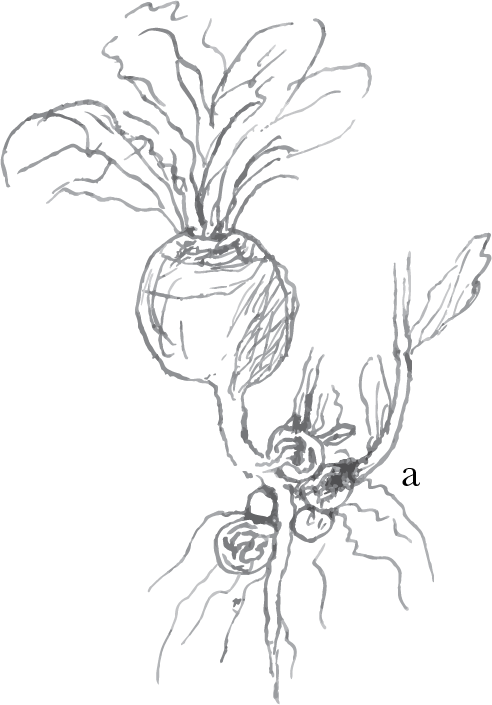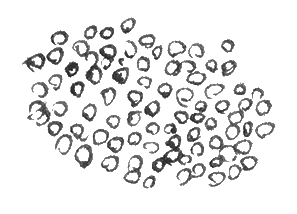From A. S. Wilson 17 February 1880
North Kinmundy, | Summerhill, | by Aberdeen.
17 Feby. 1880.
Charles Darwin Esq. F.R.S. | Down | Beckenham | Kent.
My Dear Sir,
I received your letter and feel very much gratified that you think my conclusions warranted in regard to the Russian wheats. I intend to give them another trial.1
In regard to the question you ask, I have never seen the silver fir affected with fungus in the way you describe; but I have examined to some extent the knobs on the roots of several of the Crucifers—turnips, swedes, mustard, cabbage, charlock &c. I have a paper in hand on the Plasmodioph⟨ora⟩ brassicae or cl⟨ ⟩ fungus lately discovered by Woronin, and in preparing for this, I have found that on the turnip root for example, there are knobs or clubs arising proximately from three causes.2
First there are round knobs which Woronin holds to be caused by his fungus, but in which I can find none. These nodes are in reality tuberculated buds. They are of this form:—

And they are not only capable of throwing out leaves but also a stem, and ripening seed, as I have found during last season, in the case of swedes. A stem may arise at a node a and reach a height of two or three feet. These tubercles have a certain analogy to the potato. The fibrous roots which they throw out have nothing peculiar ⟨abo⟩ut them—
⟨Se⟩cond there are the nodes or galls produced by one or more beetles for the nursing of their larvae.3 They arise thus:—

And these are also tuberculated buds. A section shows that in some way, not known to me, the piercing of the skin of the turnip and the deposit of an egg, sets free one or more medullary rays which push out the skin by the growth of a true bud the fleshy leaves of which are very obvious and sometimes even green. It is upon the bud that the young larva feeds— These nodes, I have not observed to throw out any roots—
Thirdly we have the true Club-root or Finger-and-Toe knobs or clubs, ⟨ ⟩ have many specimens of these o⟨ ⟩ of one hundred⟨th⟩ of an inch th⟨ick⟩ and upwards. These take oblong and swelling curves thus:—

These are not buds; these alone, as I think are produced by the clubroot fungus; the main feature of which is the formation from a granular plasma of enormous shoals of globular spores thus:
 the diameter of which I make .0044 mm. but which Woronin makes only about one third as large— These clubs do not throw out roots; they are upon the roots already thrown out.
the diameter of which I make .0044 mm. but which Woronin makes only about one third as large— These clubs do not throw out roots; they are upon the roots already thrown out.
Now here is a point for your consideration. Did this fungus and these beetles come by experience to know that cruciferous roots had a natural tendency to that tuberculation which ⟨ ⟩ould be advantageous to their propa⟨gatio⟩n?
I am | yours very sincerely | A Stephen Wilson.
Footnotes
Bibliography
Voronin, Mikhail Stepanovich. 1877. Plasmodiophora brassicae organizm, prichinyaiushchii kapustnym rasteniyam bolezn, izvestnuyu pod nazvaniem ‘kila’. (Plasmodiophora brassicae организм, причиняющий капустным растениям болезнь, известную под названием ‘кила’.) Trudy Sankt-Peterburgskogo obshchestva estestvoispytateley (Труды Санкт-Петербургского общества естествоиспытателей) 8: 169–201.
Summary
On clubroot fungus of cultivated Cruciferae.
Will give Russian wheat varieties another trial.
Letter details
- Letter no.
- DCP-LETT-12490
- From
- Alexander Stephen Wilson
- To
- Charles Robert Darwin
- Sent from
- Summerhill, Aberdeen
- Source of text
- DAR 181: 116
- Physical description
- ALS 4pp damaged
Please cite as
Darwin Correspondence Project, “Letter no. 12490,” accessed on 18 April 2024, https://www.darwinproject.ac.uk/letter/?docId=letters/DCP-LETT-12490.xml


